Intelligent RCS Extrapolation Technology of Target Inspired by Physical Mechanism Based on Scattering Center Model
Abstract
1. Introduction
2. Construction of SCM Based on Radar Echoes
2.1. Acquisition of Target Scattering Echoes
2.2. Parameter Extraction of SCs
- Mathematical model of SCs
- B.
- Estimating the position and type of SCs
- C.
- Extracting the amplitude of the SCs
- D.
- Simulation examples based on the GTD model
3. RCS Intelligent Extrapolation Technology Guided by Physical Mechanisms
3.1. The Challenges Faced by SCM in Application
3.2. Artificial Neural Networks Incorporating Physical Mechanism
- Dataset Generation
- B.
- Bayesian Regularization ANN
- C.
- Network Optimization
4. Numerical Simulation and Actual Measurement Verification
4.1. Electromagnetic Simulation Verification
4.2. Field Testing and Verification
5. Discussion
6. Conclusions
Author Contributions
Funding
Data Availability Statement
Conflicts of Interest
References
- Martorella, M.; Giusti, E.; Demi, L.; Zhou, Z.; Cacciamano, A.; Berizzi, F.; Bates, B. Target Recognition by Means of Polarimetric ISAR Images. Trans. Aerosp. Electron. Syst. 2011, 47, 225–239. [Google Scholar] [CrossRef]
- Novak, L.M.; Halversen, S.D.; Owirka, G.; Hiett, M. Effects of polarization and resolution on SAR ATR. Trans. Aerosp. Electron. Syst. 1997, 33, 102–116. [Google Scholar] [CrossRef]
- Wang, H.; Wei, B.; Liu, H. A Fast Method for SBR-Based Multiaspect Radar Cross Section Simulation of Electrically Large Targets. IEEE Antennas Wirel. Propag. Lett. 2022, 21, 1920–1924. [Google Scholar] [CrossRef]
- Fan, T.Q.; Guo, L.X.; Liu, W. A Novel OpenGL-Based MoM/SBR Hybrid Method for Radiation Pattern Analysis of an Antenna Above an Electrically Large Complicated Platform. IEEE Trans. Antennas Propag. 2016, 64, 201–209. [Google Scholar] [CrossRef]
- He, W.J.; Liu, X.D.; Wu, B.Y.; Yang, M.L.; Sheng, X.Q. High-Performance Simulation of Electromagnetic Scattering by 3D Objects Using the GPU-accelerated Parallel MLFMA. In Proceedings of the 2023 International Applied Computational Electromagnetics Society Symposium (ACES-China), Hangzhou, China, 16–18 August 2023; pp. 1–2. [Google Scholar]
- Ling, H.; Chou, R.C.; Lee, S.W. Shooting and bouncing rays: Calculating the RCS of an arbitrarily shaped cavity. IEEE Trans. Antennas Propag. 1989, 37, 194–205. [Google Scholar] [CrossRef]
- Shah, M.A.; Tokgöz, Ç.; Salau, B.A. Radar Cross Section Prediction Using Iterative Physical Optics with Physical Theory of Diffraction. IEEE Trans. Antennas Propag. 2022, 70, 4683–4690. [Google Scholar] [CrossRef]
- Kasdorf, S.; Troksa, B.; Key, C.; Harmon, J.; Notaroš, B.M. Advancing Accuracy of Shooting and Bouncing Rays Method for Ray-Tracing Propagation Modeling Based on Novel Approaches to Ray Cone Angle Calculation. IEEE Trans. Antennas Propag. 2021, 69, 4808–4815. [Google Scholar] [CrossRef]
- Aguilar, A.G.; Van Tonder, J.; Jakobus, U.; Illenseer, F. Overview of recent advances in the electromagnetic field solver FEKO. In Proceedings of the 2015 9th European Conference on Antennas and Propagation (EuCAP), Lisbon, Portugal, 13–17 April 2015; pp. 1–5. [Google Scholar]
- Tao, Y.B.; Lin, H.; Bao, H. KD-tree based fast ray tracing for RCS prediction. Prog. Electromagn. Res. 2008, 81, 329–341. [Google Scholar] [CrossRef]
- Mansukhani, J.; Penchalaiah, D.; Bhattacharyya, A. Rcs based target classification using deep learning methods. In Proceedings of the 2021 2nd International Conference on Range Technology (ICORT), Balasore, India, 5–6 August 2021; pp. 1–5. [Google Scholar]
- Zhao, J.C.; Zhang, K.; Yang, Z.; Li, Y. Research on Radar Cross Section Scaling Relation based on Neural Network. In Proceedings of the 2022 IEEE Conference on Antenna Measurements and Applications (CAMA), Guangzhou, China, 14–17 December 2022; pp. 1–4. [Google Scholar]
- Chen, H.; Yang, C.; Du, Y. Machine learning-assisted analysis of polarimetric scattering from cylindrical components of vegetation. IEEE Trans. Geosci. Remote Sens. 2018, 57, 155–165. [Google Scholar] [CrossRef]
- Xiao, D.H.; Guo, L.X.; Liu, W.; Hou, M.Y. Efficient RCS prediction of the conducting target based on physics-inspired machine learning and experimental design. IEEE Antennas Wirel. Propag. Lett. 2020, 69, 2274–2289. [Google Scholar] [CrossRef]
- Jacobs, J.P.; Du Plessis, W. Efficient modeling of missile RCS magnitude responses by Gaussian processes. IEEE Antennas Wirel. Propag. Lett. 2017, 16, 3228–3231. [Google Scholar] [CrossRef]
- Lee, S.Y.; Park, C.S.; Park, K.; Lee, H.J.; Lee, S. A Physics-informed and data-driven deep learning approach for wave propagation and its scattering characteristics. Eng. Comput.-Ger. 2023, 39, 2609–2625. [Google Scholar] [CrossRef]
- Wei, Z.; Chen, X.D. Deep-learning schemes for full-wave nonlinear inverse scattering problems. IEEE Trans. Geosci. Remote Sens. 2018, 57, 1849–1860. [Google Scholar] [CrossRef]
- Liu, J.; He, S.Y.; Zhang, L.; Zhang, Y.H.; Zhu, G.Q.; Yin, H.C.; Yan, H. An Automatic and Forward Method to Establish 3-D Parametric Scattering Center Models of Complex Targets for Target Recognition. IEEE Trans. Geosci. Remote Sens. 2020, 58, 8701–8716. [Google Scholar] [CrossRef]
- He, S.Y.; Hua, M.B.; Zhang, Y.H.; Du, X.Y.; Zhang, F. Forward Modeling of Scattering Centers From Coated Target on Rough Ground for Remote Sensing Target Recognition Applications. IEEE T. Geosci. Remote. 2024, 62, 1–17. [Google Scholar] [CrossRef]
- Cui, S.; Li, S.; Yan, H. A method of 3-D scattering center extraction based on ISAR images. In Proceedings of the 2016 IEEE International Conference on Electronic Information and Communication Technology (ICEICT), Harbin, China, 20–22 August 2016; pp. 439–442. [Google Scholar]
- Qu, Q.Y.; Guo, K.Y.; Sheng, X.Q. Scattering Centers Induced by Creeping Waves on Cone-Shaped Targets in Bistatic Mode. IEEE T. Antenn. Propag. 2015, 63, 3257–3262. [Google Scholar] [CrossRef]
- Huang, K.; He, S.Y.; Zhang, Y.H.; Yin, H.C.; Bian, Z.D.; Zhu, G.Q. Composite Scattering Analysis of the Ship on a Rough Surface Based on the Forward Parametric Scattering Center Modeling Method. IEEE Antennas Wirel. Propag. Lett. 2019, 18, 2493–2497. [Google Scholar] [CrossRef]
- Wang, J.; Zhou, J.J. Modified MEMP method for 2D scattering center measurement based on GTD model. In Proceedings of the 2008 International Conference on Microwave and Millimeter Wave Technology (ICMMT), Nanjing, China, 21–24 April 2008; pp. 987–990. [Google Scholar]
- Zheng, S.Y.; Zhang, X.K.; Guo, Y.D.; Zong, B.F.; Xu, J.H. An improved 2D-TLS-ESPRIT algorithm of GTD model parameter estimation. J. Beijing Univ. Aeronaut. Astronaut. 2020, 46, 1982–1989. [Google Scholar]
- Yun, D.J.; Jung, H.; Kang, H.; Kim, J.; Park, I.Y.; Lee, H.R.; Kim, Y.D. Scattering Center Extraction for ISAR Image using Deep Neural Network. In Proceedings of the 2023 20th European Radar Conference (EuRAD), Berlin, Germany, 20–22 September 2023; pp. 177–180. [Google Scholar]
- Wei, Y.; Li, J.; Gu, C. Study on two-dimensional electromagnetic scattering based on BP neural network. In Proceedings of the 2022 IEEE 4th International Conference on Civil Aviation Safety and Information Technology (ICCASIT), Dali, China, 12–14 October 2022; pp. 888–891. [Google Scholar]
- Fan, T.Q.; Guo, L.X.; Lv, B.; Liu, W. An Improved Backward SBR-PO/PTD Hybrid Method for the Backward Scattering Prediction of an Electrically Large Target. IEEE Antennas Wirel. Propag. Lett. 2016, 15, 512–515. [Google Scholar] [CrossRef]
- Ando, M.; Lu, P. Geometrical optics and diffraction extracted from Physical Optics by surface to line integral reduction using modified edge representation. In Proceedings of the Asia-Pacific Microwave Conference 2011, Melbourne, Australia, 5–8 December 2011; pp. 1937–1940. [Google Scholar]
- Jin, K.S.; Suh, T.I.; Suk, S.H.; Kim, B.C.; Kim, H.T. Fast Ray Tracing Using A Space-Division Algorithm for RCS Prediction. J. Electromagnet. Wave 2006, 20, 119–126. [Google Scholar] [CrossRef]
- Guo, W.; Yang, M.; Chen, B.; Zheng, G. Joint DOA and polarization estimation using MUSIC method in polarimetric MIMO radar. In Proceedings of the IET International Conference on Radar Systems (Radar 2012), Glasgow, UK, 22–25 October 2012; pp. 1–4. [Google Scholar]
- Ning, Y.M.; Ma, S.; Meng, F.Y.; Wu, Q. DOA Estimation Based on ESPRIT Algorithm Method for Frequency Scanning LWA. IEEE Commun. Lett. 2020, 24, 1441–1445. [Google Scholar] [CrossRef]
- Sahnoun, S.; Usevich, K.; Comon, P. Multidimensional ESPRIT for Damped and Undamped Signals: Algorithm, Computations, and Perturbation Analysis. IEEE Trans. Signal Process. 2017, 65, 5897–5910. [Google Scholar] [CrossRef]
- Zhu, F.Y.; Chai, S.R.; Zou, Y.F.; He, Z.X.; Guo, L.X. An Efficient and Accurate RCS Reconstruction Technique Using Adaptive TLS-ESPRIT Algorithm. IEEE Antennas Wirel. Propag. Lett. 2024, 23, 49–53. [Google Scholar] [CrossRef]
- Zheng, S.Y.; Zhang, X.K.; Zong, B.F.; Li, J. GTD Model Parameters Estimation Based on Improved LS-ESPRIT Algorithm. In Proceedings of the 2019 Photonics & Electromagnetics Research Symposium (PIERS), Xiamen, China, 17–20 December 2019; pp. 2282–2289. [Google Scholar]
- Fiorentini, N.; Pellegrini, D.; Losa, M. Overfitting prevention in accident prediction models: Bayesian regularization of artificial neural networks. Transp. Res. Rec. 2023, 2677, 1455–1470. [Google Scholar] [CrossRef]
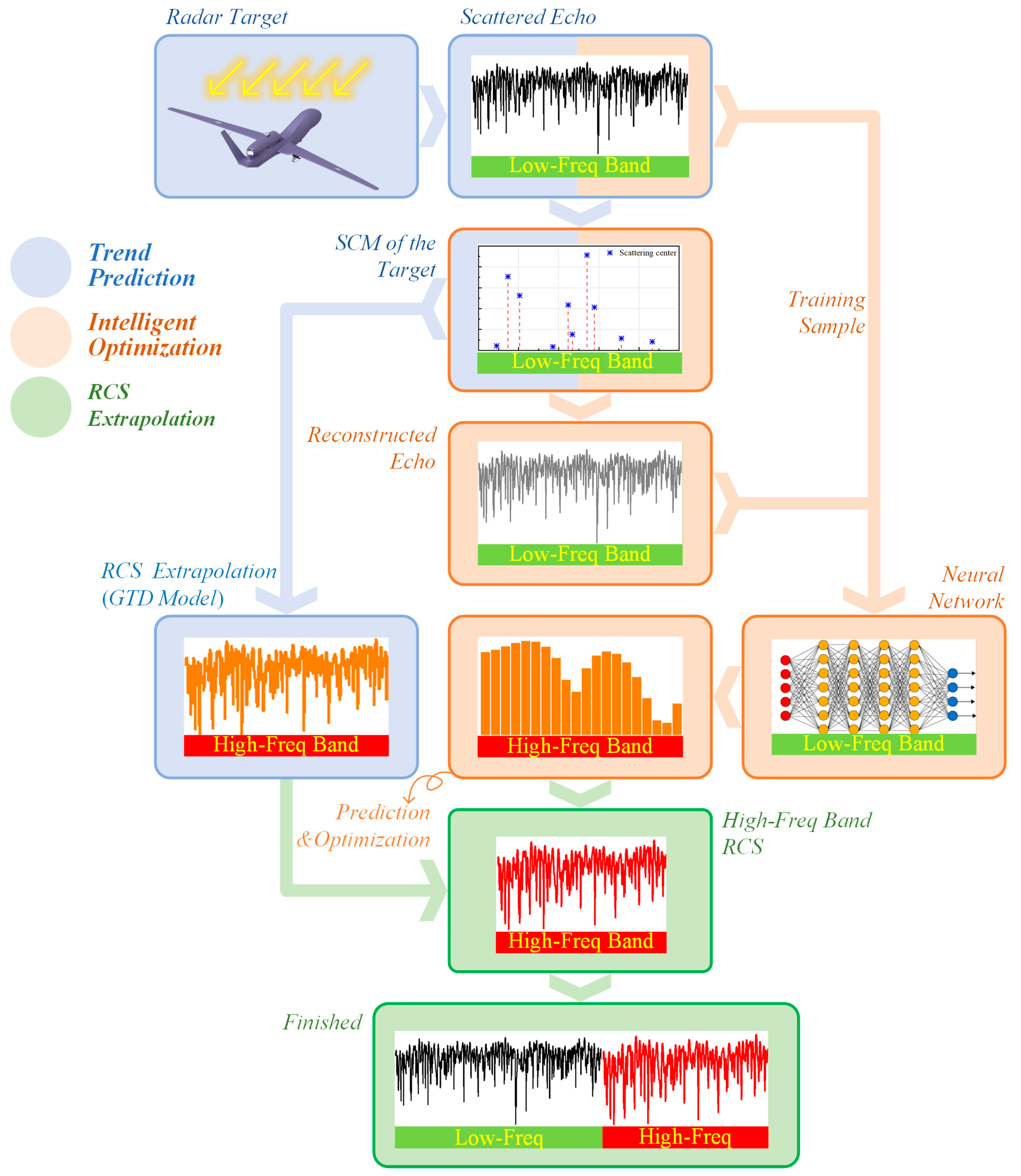

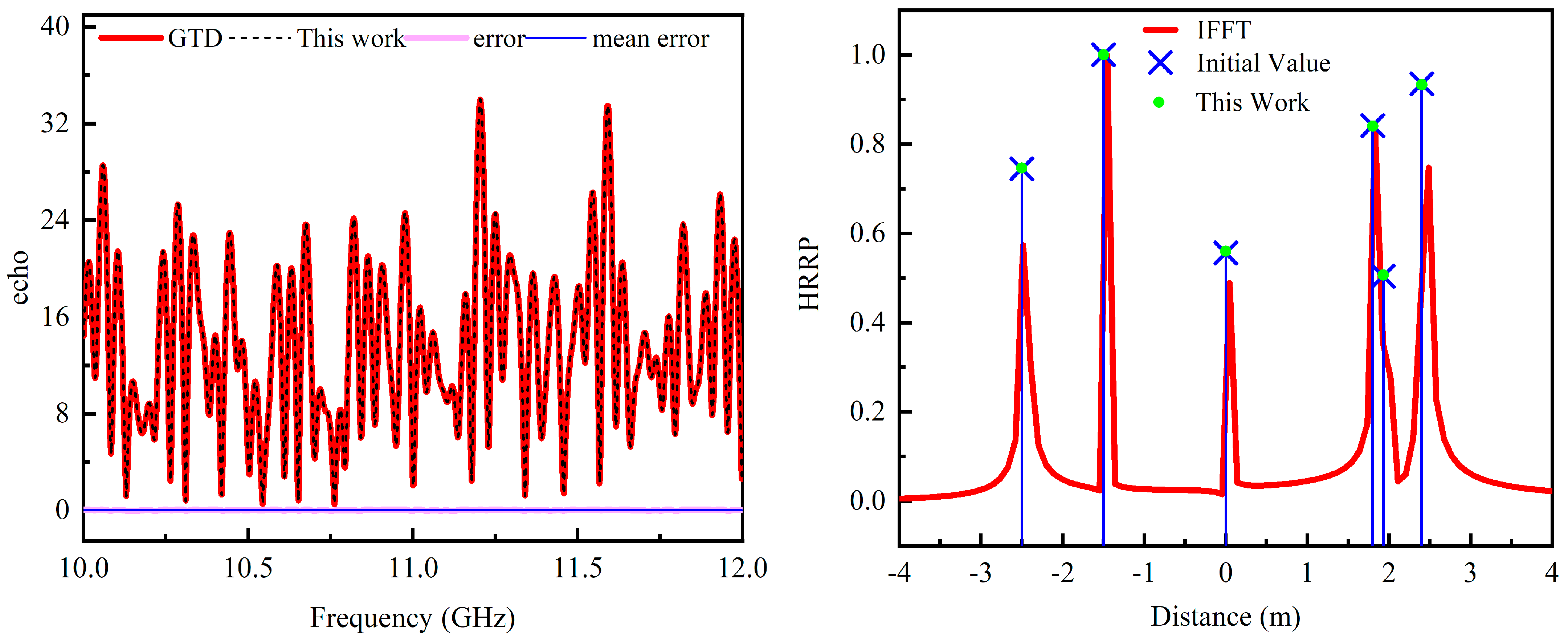
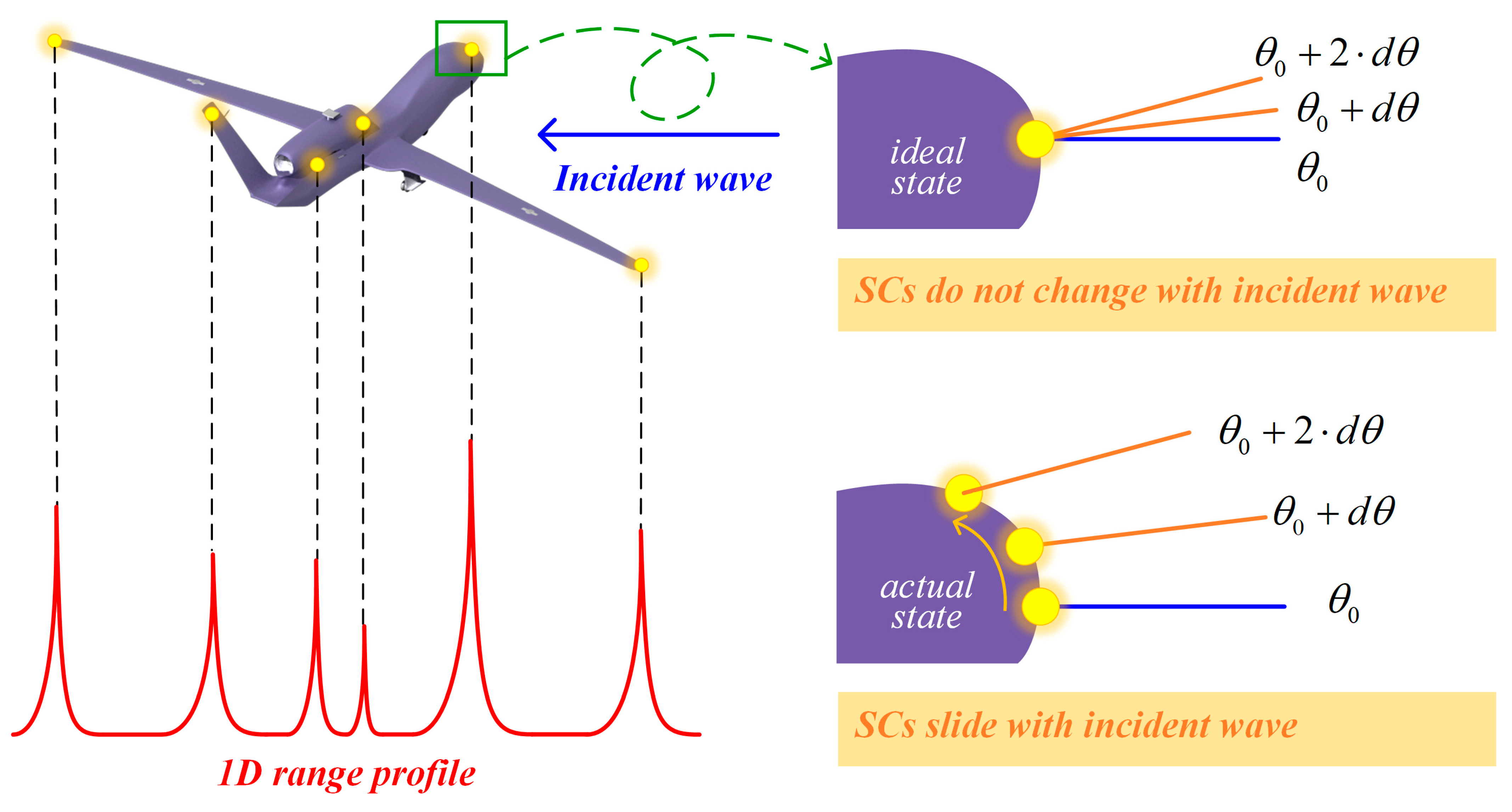




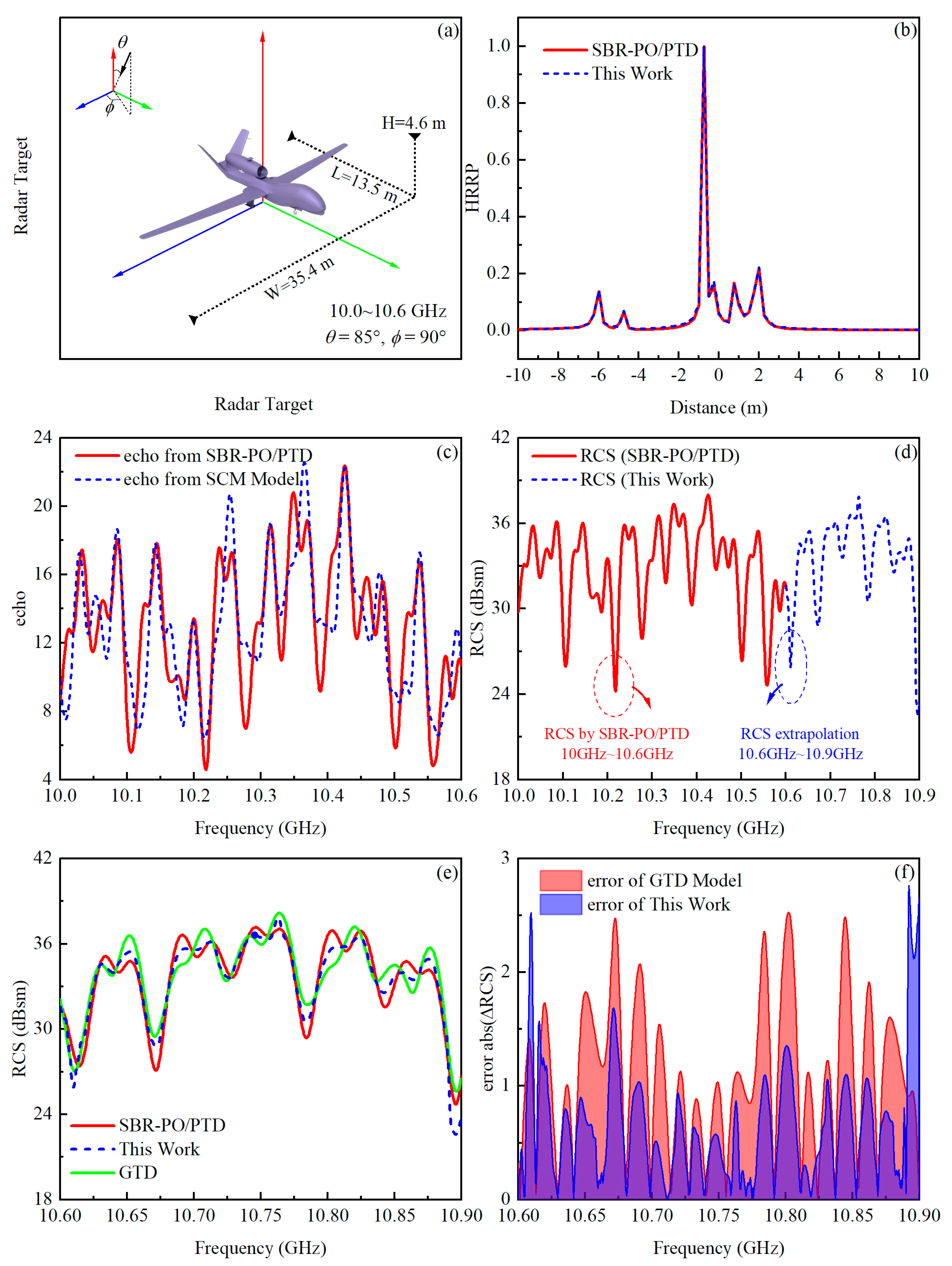
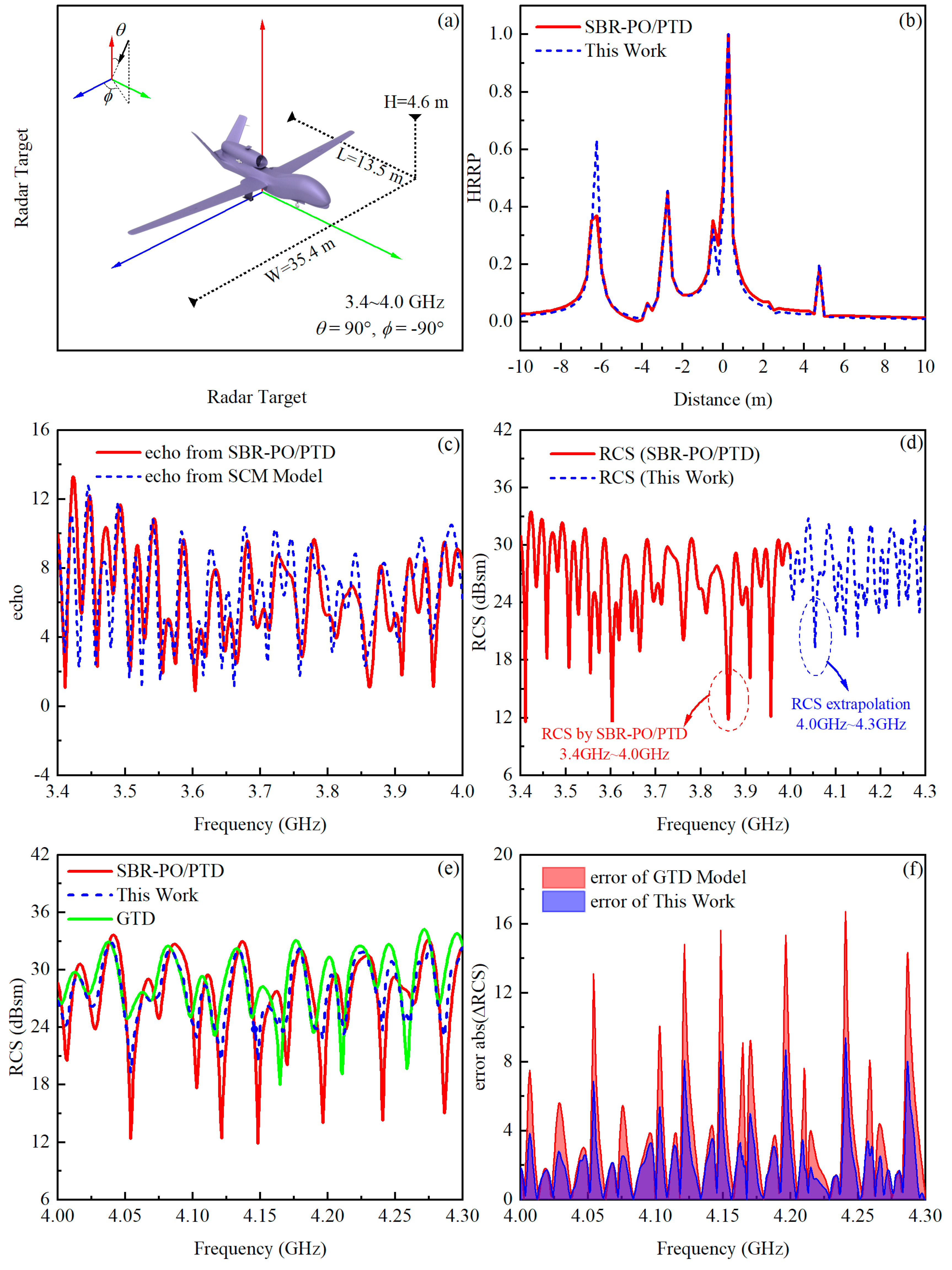


| α Values | Typical Scattering Structures |
|---|---|
| 1 | Plane reflection, dihedral angle scattering |
| 0.5 | Single surface reflection, cylindrical reflection |
| 0 | Point scattering, hyperboloid scattering, straight mirror reflection |
| −0.5 | Edge diffraction |
| −1 | Top diffraction |
| Group A (GTD Model) | Group B (Adaptive TLS-ESPRIT) | |||||
|---|---|---|---|---|---|---|
| S/N | α | r | A | α | r | A |
| 1 | 0 | −2.50 | 5.60 | 0 | −2.50 | 5.60 |
| 2 | 0.5 | −1.50 | 7.50 | 0.5 | −1.50 | 7.52 |
| 3 | −1 | 0.00 | 4.20 | −1 | 0.00 | 4.18 |
| 4 | 1 | 1.80 | 6.30 | 1 | 1.80 | 6.33 |
| 5 | −0.5 | 1.93 | 3.80 | −0.5 | 1.93 | 3.79 |
| 6 | 1 | 2.40 | 7.00 | 1 | 2.40 | 7.03 |
| Target | Frequency (GHz) | Polar Angle | Azimuth Angle | Sampling Number | Polarization |
|---|---|---|---|---|---|
| Aircraft | 3.4~4.0 | 20 × 20 = 400 | HH | ||
| 4.0~4.6 | 30 × 20 = 600 | HH | |||
| 10.0~10.6 | 20 × 20 = 400 | HH | |||
| Tank | 1.00~1.66 | 20 × 20 = 400 | HH |
| S/N | Low-Freq Band (GHz) | Extrapolation Band (GHz) | RMSE of Echo (dB) | Echo of GTD | Echo of SCM−ANN | Error Reduction (%) |
|---|---|---|---|---|---|---|
| Figure 7 | 4.0~4.6 | 4.6~4.9 | 2.2 | 1.47 | 0.82 | 44.2% |
| Figure 8 | 4.0~4.6 | 4.6~4.9 | 2.7 | 3.75 | 1.92 | 48.8% |
| Figure 9 | 10.0~10.6 | 10.6~10.9 | 2.8 | 1.11 | 0.65 | 40.5% |
| Figure 10 | 3.4~4.0 | 4.0~4.3 | 2.4 | 3.55 | 2.08 | 41.4% |
Disclaimer/Publisher’s Note: The statements, opinions and data contained in all publications are solely those of the individual author(s) and contributor(s) and not of MDPI and/or the editor(s). MDPI and/or the editor(s) disclaim responsibility for any injury to people or property resulting from any ideas, methods, instructions or products referred to in the content. |
© 2024 by the authors. Licensee MDPI, Basel, Switzerland. This article is an open access article distributed under the terms and conditions of the Creative Commons Attribution (CC BY) license (https://creativecommons.org/licenses/by/4.0/).
Share and Cite
Zhu, F.-Y.; Chai, S.-R.; Guo, L.-X.; He, Z.-X.; Zou, Y.-F. Intelligent RCS Extrapolation Technology of Target Inspired by Physical Mechanism Based on Scattering Center Model. Remote Sens. 2024, 16, 2506. https://doi.org/10.3390/rs16132506
Zhu F-Y, Chai S-R, Guo L-X, He Z-X, Zou Y-F. Intelligent RCS Extrapolation Technology of Target Inspired by Physical Mechanism Based on Scattering Center Model. Remote Sensing. 2024; 16(13):2506. https://doi.org/10.3390/rs16132506
Chicago/Turabian StyleZhu, Fang-Yin, Shui-Rong Chai, Li-Xin Guo, Zhen-Xiang He, and Yu-Feng Zou. 2024. "Intelligent RCS Extrapolation Technology of Target Inspired by Physical Mechanism Based on Scattering Center Model" Remote Sensing 16, no. 13: 2506. https://doi.org/10.3390/rs16132506
APA StyleZhu, F.-Y., Chai, S.-R., Guo, L.-X., He, Z.-X., & Zou, Y.-F. (2024). Intelligent RCS Extrapolation Technology of Target Inspired by Physical Mechanism Based on Scattering Center Model. Remote Sensing, 16(13), 2506. https://doi.org/10.3390/rs16132506









